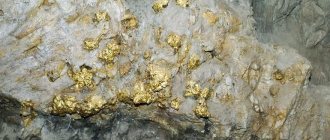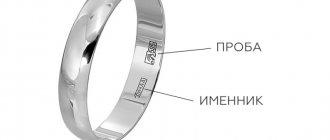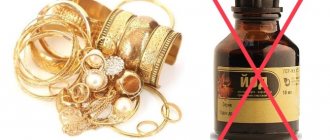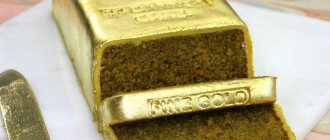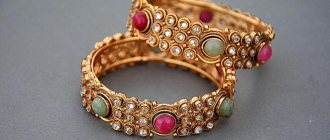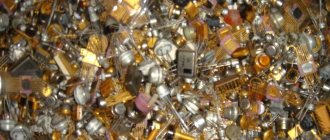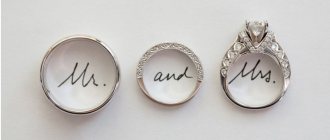For centuries, gold was considered the most valuable noble metal, which played a key role in a wide variety of areas of human activity.
But if in ancient times there were no specific methods for extracting this material, in addition to developing mines, then today things are much better and it is possible to extract a certain amount of gold from stone.
Noble solar metal in field conditions, primary deposits, what it looks like, places of localization
Precious metal can be found among rocks, mountains, ore, lake and sea sand. Natural reserves are limited, and throughout its history, humanity has mined about 200 thousand tons of this metal.
In nature, the precious metal looks completely different from what it does on the shelves of jewelry boutiques. It can be of various shades: from emerald gray to crimson.
Particles of solar metal are present in many different stones, but in such tiny quantities that they are of no value. A person who wants to engage in serious gold mining will have to rely on fortune and know the principles of calculating deposits.
Stones containing gold
The most common place for metal localization is quartz layers. This is where large nuggets are discovered. Bottom sediments are found at the bottom of rivers.
Historical facts
If you familiarize yourself with historical facts, you will know that during the times of Ancient Rus', the state had practically no gold deposits, despite its vast area. Prince Ivan III devoted a significant part of his life to the issue of searching for precious metals, because he was practically obsessed with the idea of \u200b\u200bsearching for treasures. To realize his dream, he even invited Italian specialists and allocated impressive sums. But the efforts were not justified; he managed to find only a small piece of gold, which was only enough to make a tiny cross.
After him, Ivan the Terrible began to actively search for yellow sand. To find the valuable metal, he even went to war against the Siberian settlements, but was also doomed to failure. A similar story happened with the rest of the rulers of Ancient Rus', until a turning point in the history of the state occurred. This was the rise to power of Peter I. The legendary ruler began to actively introduce clothing items and jewelry containing precious metals and valuable stones.
The first gold nugget was mined by a Ural peasant in 1945. This happened spontaneously while digging a hole. The happy owner of the precious stone immediately showed the find to a friend, who turned out to be a silversmith and confirmed the authenticity of the nugget.
The place where the find was discovered immediately attracted the attention of specialists, which led to the start of numerous search operations. However, they were unable to find anything, so work was suspended. Soon the authorities decided to resume the search and equip the mine. This decision paid off. At the bottom of the dug mine there was an impressive amount of gold reserves, which became the basis for large-scale gold mining.
Since ancient times, people have been interested in the idea of mining gold at home. Today, this trend is no less popular, only the methods of its implementation have changed significantly. Of course, you won’t be able to get rich through private gold mining, but finding a new hobby, as well as a little extra income, is quite possible.
What kind of stones and types contain gold?
It is difficult for a person for whom gold mining is new to determine whether a stone contains a precious metal. Pure gold is practically never found, and its alloys have different shades and intensity of shine.
So, what stones contain gold? Let's find out.
Igneous body
Most often, the metal is found in intrusive rock, formed when magma reaches the surface.
Quartz crystals
Quartz is one of the most common minerals on Earth; its name translates as “hard.” It is a true companion of gold, but not all crystals contain it.
Quartz veins attract increased attention from miners. Such ore masses especially often contain gold metal.
Gold-bearing quartz can be yellow, brown, blue or gray in color due to the presence of sulfides. Sulfides are another satellite of gold.
What to do if you find a gold nugget
Native gold is the property of the state. For legal production, a license is issued. Next, the raw materials with precious metal are supplied to refineries.
If a nugget is found by chance, and this often happens at deposits, it must be handed over to the local tax authority. The finder will receive a 20% reward from the value of native gold (Article 229 of the Civil Code of the Russian Federation). Income and pension taxes will be withheld from the amount, and the remaining money will be transferred to a bank card.
Watch vlogs of how amateurs search for precious stones:
How to test a stone for gold
Solar metal can easily be confused with pyrite. During the exploration of Mexico, Spanish conquistadors loaded their ships to capacity with pyrite, mistaking it for gold.
There are two reliable ways to help recognize a real precious metal:
Scratch
The easiest way to check is to scratch the gold-plated surface with a thin needle. The result must be assessed through a magnifying glass. Solar metal does not crumble under mechanical stress.
Place in sulfuric acid
You can try placing the found particles in a test tube with sulfuric acid. Next you need to monitor what the reaction will be. In its absence, we can conclude that the find really turned out to be gold.
You can also distinguish precious metals from “fake” ones with the help of iodine and brilliant green.
Gold in acid
About jewelry with pyrite
In jewelry, pyrite products came into fashion in the 20th century thanks to the company Butler & Wilson. The company's jewelers created exclusive jewelry from pyrite, a simple ornamental stone. The “pyrite fever” began with them.
Jewelry with pyrite
Our “Alpine diamond” is a democratic mineral. It can be worn “to a feast, and to the world, and to good people.” Of course, if you appeared at high-status parties wearing jewelry made of “clown’s gold,” people might not understand you.
But in autumn or spring bad weather, the joyful golden-yellow color of the mineral will give you vigor.
For women, earrings paired with a pendant are suitable. A man will be decorated with a bracelet with pyrites. Young fashionistas will love baubles with a yellow, sunny stone.
3 options for processing ore in search of gold
Obtaining pure metal from gold-containing stones is not an easy task, requiring special equipment and knowledge in chemistry. There are three main methods of processing ore; let’s look at them in more detail.
Chemical using aggressive acids
This method is characterized by contact of ore with aggressive chemicals. To obtain the result, you need to select the right acid, which will dissolve foreign elements without affecting the gold. The precious metal will fall out as sediment.
The secret of the method is that it is almost impossible to dissolve gold using aggressive acids. For these purposes, only concentrated chlorine, amalgam, and aqua regia are suitable.
Concentrated chlorine and stone with gold
Dry by rock crushing
This method is the most expensive and requires increased security measures.
Who is contraindicated for aventurine?
Not all people benefit from aventurine. For some categories, the energy of aventurine may be negative:
- People born under the constellations of Aries, Leo and Sagittarius may suffer significant financial losses and be disappointed in life. Traits of cynicism and fatalism appear in their character, and negative personality traits become aggravated. Such people turn into quarrelsome, hysterical individuals.
- Aventurine is not suitable for people born under the sign of Capricorn.
- People who are emotionally unbalanced and excitable should not wear jewelry with this mineral.
- The mineral is completely unsuitable for people holding responsible positions and strictly adhering to the rules. Although, it should be noted, such people never rely only on luck.
Even if aventurine suits you perfectly, you should not wear it for more than one lunar cycle. It is best to wear jewelry during the waning lunar phase.
If you do not adhere to these rules, capricious luck may turn away , and the owner of the stone will become emotionally unstable.
Geography of places attractive to prospectors. Gold-bearing rivers of Russia
You don't have to go to the Klondike to feel the spirit of the gold rush. Russia is extremely rich in placer gold.
Around the first half of the 19th century, the term “Siberian gold” appeared. The Irkutsk region and Krasnoyarsk region turned out to be rich in many gold deposits. They were discovered inside the basins of the Ob, Tom, and Yenisei rivers. Now the Siberian precious metal is the basis of the gold mining industry of the Russian Federation.
In Bashkiria, gold was discovered in the valleys of 7 rivers in the Uchalinsky region. Nuggets weighing about 16 kilograms were found here. At the moment, gold mining in these territories is not developing so actively, although it has excellent prospects.
How are gold nuggets formed and where can you find them?
There is no evidence of exactly how the natural precious metal was formed. Previously it was believed that it increased due to crystallization, as during the formation of granite. Most scientists recognize the original molten state of native gold with the same composition as now. Perhaps the process began during volcanic eruptions, then the metal cooled in the cavities of the rock.
The main deposits of gold nuggets in Russia:
- Natalkinskoye (Omchak river, Magadan region);
View this post on Instagram
Posted by magan15 (@magan153689) Oct 14, 2022 at 11:04 am PDT
- Nezhdaninskoe (Yakutia);
View this post on Instagram
Publication from Industry of Russia and the World (@tekkos_russia) February 10, 2022 at 5:13 PST
- Olimpiadinskoye and Blagodatnoye (Krasnoyarsk Territory);
View this post on Instagram
Posted by Ivan (@ivankrivogov) Oct 28, 2022 at 6:34 am PDT
- Darasunskoe (Chita region).
In the Urals, native precious metal abounds in the Tash-Targanka river (near Miass), Moss swamp, Bolsheshaldinskaya placer and quarries in the Sverdlovsk region. The Kajaran and Sotskoe deposits are famous in Armenia.
A metal detector and a mini-dredge (a device for washing the soil) will make the search easier.
Which metal detector is better to take for a search:
- pulse;
- multi-frequency (from 6 to 60 kHz);
- with the ability to work underwater (waterborne).
In equipment reviews, experts highlight the Minelab Eureka Gold and Nokta Fors Gold metal detectors.
It is advisable to search not far downstream or along the perimeter of the quarry. In these zones there is a higher probability of finding nuggets. In swampy and excessively wet soils, it is recommended to do blind mole. That is, to drain water, holes with a diameter of 6–8 cm are drilled to a depth of 50 cm and with a frequency of 1 piece per 1–2 m.
Gold laundering sites in other countries
Modern treasure hunters should pay attention to the following countries:
1. Republic of Ghana, West Africa: no legal restrictions, the Tarkwa region includes 4 gold-bearing places.
2. Indonesia: to carry out gold mining you will need a license, which local authorities issue even to tourists.
3. Norway: the mountain rivers of this country attract many miners every year; a license is required to launder gold.
4. Finland: the Ivailoki River is famous for the presence of loose solar metal.
5. Australia: the most attractive country for gold miners; the authorities issue not only licenses to operate, but also the necessary equipment. To launder precious metals, it is worth visiting areas of the state such as Victoria and South Wales.
How to extract gold from stone at home
You can extract gold from stone at home. When deciding on a suitable refining method, you need to know all the main characteristics of the precious metal.
Consider a method using bleach.
First, the stone should be crushed, after firing it with a burner. Only after this the crushing equipment is used.
Most often, the gold in the stone is small and cannot be seen with the naked eye. Therefore, the rock is crushed into dust by a crusher.
The crushed material must be filled with sulfuric acid and bleach. Regular bleach will do for cleaning bathtubs. To accelerate the reaction, all elements must be mixed and then left for 6 hours. Next, start filtering.
Modern mining technologies
The mined ore from the quarry is delivered by dump trucks to the processing plant, where the raw materials undergo primary processing:
- sorting, depending on the percentage of metal;
- mixing batches to form a homogeneous composition according to the degree of gold presence;
- screening out large inclusions, which are separately subjected to additional grinding;
- grinding of raw materials into a dusty mass and subsequent enrichment with the addition of water, preparation of material ready for processing by flotation - saturation with air;
- introduction of chemical reagents that promote the separation of gold;
- foam is selected from the resulting composition (directly – gold suspension), thickened using special reagents;
- the next stage is squeezing out excess water in press filters;
- The dehydrated material is dried in ovens at high temperatures and crushed.
One ton of the concentrate obtained after processing contains up to fifty grams of gold.
The products of the processing plant are finally converted into precious metal after smelting at a hydrometallurgical plant.

